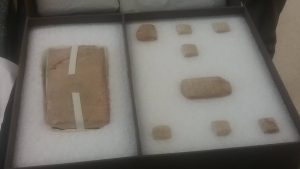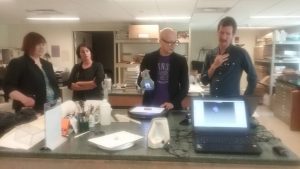 Colgate University’s Special Collections and University Archives houses an array of written materials and items related to the history of the University, and includes a series of Sumerian cuneiforms that date back to approximately 2100 to 2200 B.C. One of the earliest forms of writing, Colgate’s cuneiforms depict the financial transactions of the time. A “traveling” set of the cuneiforms are frequently transported to a variety of classrooms for faculty and students to view.
Colgate University’s Special Collections and University Archives houses an array of written materials and items related to the history of the University, and includes a series of Sumerian cuneiforms that date back to approximately 2100 to 2200 B.C. One of the earliest forms of writing, Colgate’s cuneiforms depict the financial transactions of the time. A “traveling” set of the cuneiforms are frequently transported to a variety of classrooms for faculty and students to view.
In 2015 Colgate’s Academic Technologies team experimented with 3D scanning, modeling, and printing technologies to increase awareness of, and access to, these technologies within the Colgate community. Through this work, Sarah Keen, Head of Special Collections and University Archivist at Colgate, expressed an interest in reproducing the “traveling” cuneiform collection.
Several Colgate staff members, Douglas Higgins, Instructional Technologist, Allison Grim, Conservation Technician, and Rich Grant, Technical Director for Academic and Media Technologies worked to reproduce the set using multiple techniques. However, these techniques could not reproduce the details of the items.
During this time Doug Higgins collaborated several times with Ian Roy, Head of MakerLab / Assistant Director of Research Technology and Innovation, at Brandeis University, and Jordan Tynes, Manager of Scholarly Innovations, at Wellesley College. They agreed to provide their equipment and knowledge to Colgate to support the completion of this project.
 On August 17, 2016, Mr. Roy and Mr. Tynes visited the University to 3D scan the “traveling” cuneiforms using two Spider scanners from Artec3D. With a 0.1 millimeter resolution the scanners are ideal for “heritage preservation.” It took approximately 10
On August 17, 2016, Mr. Roy and Mr. Tynes visited the University to 3D scan the “traveling” cuneiforms using two Spider scanners from Artec3D. With a 0.1 millimeter resolution the scanners are ideal for “heritage preservation.” It took approximately 10
to 15 minutes to scan and generate a digital model of each cuneiform. The models are available to be viewed on the Hub’s Sketchfab site. These digital models allow us to share the cuneiforms beyond our local community or recreate them with 3D printing. In addition, the models reveal details not visible with the naked eye.
The applications for teaching, learning, and research of these 3D technologies are limitless. Objects from remote locations can be shared with colleagues to support research, or digitally and physically brought into the classroom for study. Digital collections could be made accessible to the local and global Colgate community. The Academic Technologies group is currently exploring ways to secure this type of equipment for the faculty, students, and staff at Colgate.
Written by Douglas Higgins
